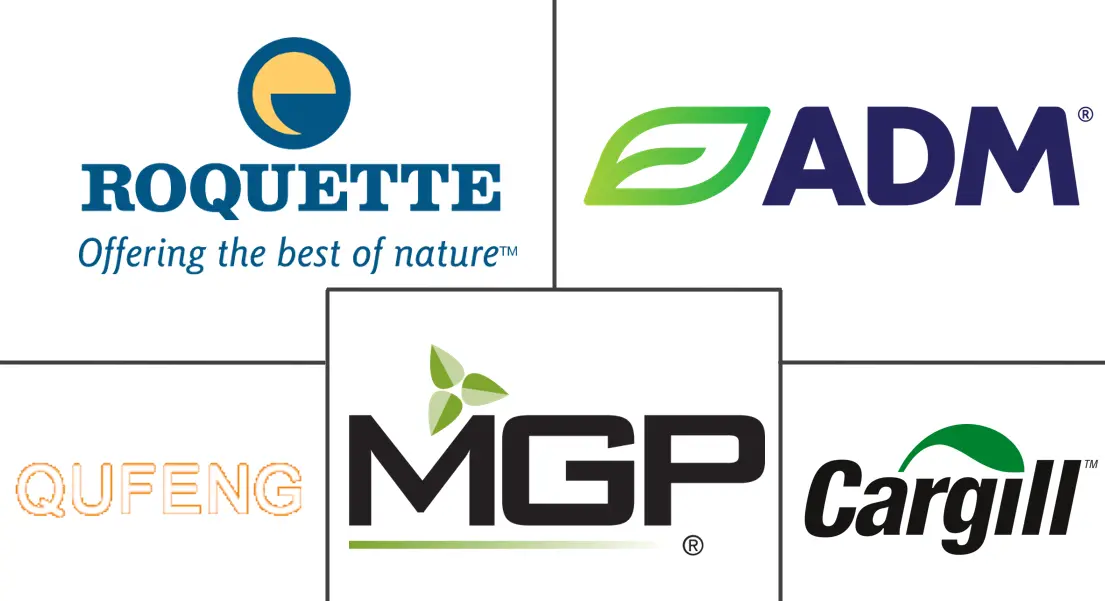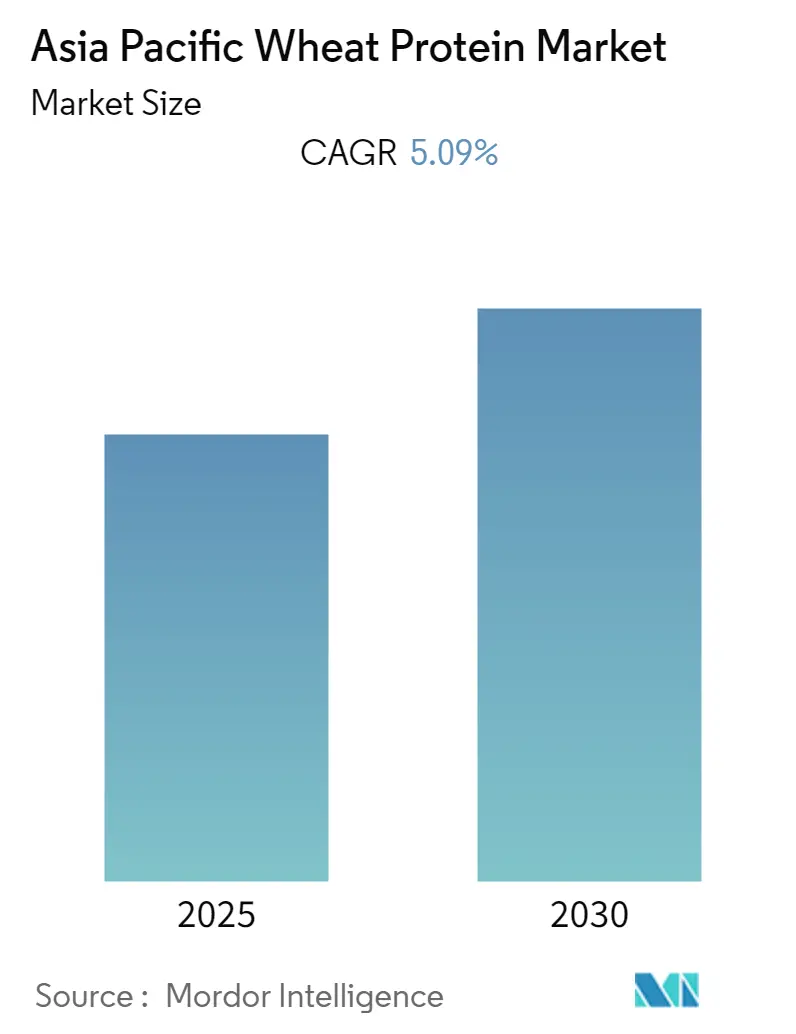
Asia Pacific Wheat Protein Market Analysis by Mordor Intelligence
The Asia Pacific Wheat Protein Market is expected to register a CAGR of 5.09% during the forecast period.
- The market has witnessed significant growth due to the increasing intolerance towards animal protein, thereby leading to the shift in preference of the meat-consuming population toward meat substitutes made of vegan protein, therefore driving the market studied. In addition, major benefits such as high nutritional value and a good source of several proteins, with the growing demand for natural and organic substitutes, thus driving the market growth in the coming years.
- Additionally, there has been a significant increase in the demand for wheat protein application in animal feed due to growing awareness regarding animal health, which is anticipated to drive the demand for wheat protein. According to the National Bureau of Statistics of China, the production volume of beef and veal across China amounted to approximately 7,180 thousand metric tons in the year 2022. Hence, the increasing trend of cattle rearing for the production of beef, veal, and other such products also offers lucrative opportunities for the growth of the wheat protein market across the Asia-Pacific region.
- Moreover, companies in the region have initiated awareness programs and campaigns, which are directed to make consumers understand the benefits of alternative proteins and establish popularity among consumers, which is expected to further drive the market growth during the study period. Additionally, there has been a rise in the popularity of meat substitutes across the region. Hence, players have been innovating solutions to produce meat alternative products.
- For instance, in December 2022, Harvest B opened its first plant-based meat ingredient facility in Australia. The company offers a range of plant-based meat ingredients, including an array of wheat-textured plant proteins. Such developments, coupled with the rise in demand for wheat proteins for various applications in end-user industries, are expected to propel the market studied over the forecast period.
Asia Pacific Wheat Protein Market Trends and Insights
Rising Demand for Plant-Based Food & Beverages
- There is a growing demand for plant-based food and beverages across the region. Especially, easy-to-cook or ready-to-eat meals have been gaining traction due to the busy lifestyle, rising healthy packaged food consumption, rising consumption of breakfast cereal, changing dietary patterns, and an increasing number of convenience stores that are driving the demand for wheat protein ingredients among packaged food manufacturers across the region.
- The shift in consumer demand from animal protein to plant protein can be witnessed with the expansion of the wheat protein market. This gradual inclination toward a plant-based diet is largely associated with different factors, such as sustainability issues, health awareness, ethical or religious views, and environmental and animal rights.
- Hence, the countries in the region have been importing substantial amounts of wheat proteins to meet the demand for the same. For example, according to the Japan Plant Protein Food Association, the shipment volume of wheat proteins in the nation was approximately 18.35 thousand metric tons in the year 2022.
- Additionally, the increased production of wheat leading to the easy availability of raw materials for players offering wheat protein isolates and other wheat protein products are expected to drive the demand for the products.
- As per the National Bureau of Statistics of China, in the year 2021, the production of wheat across the nation was 136.95 million metric tons. The economical cost of the raw materials helps the manufacturers offer their wheat protein products at competitive prices. The increasing application of wheat proteins for food and beverages and other such industries is expected to boost the market studied during the forecast period.
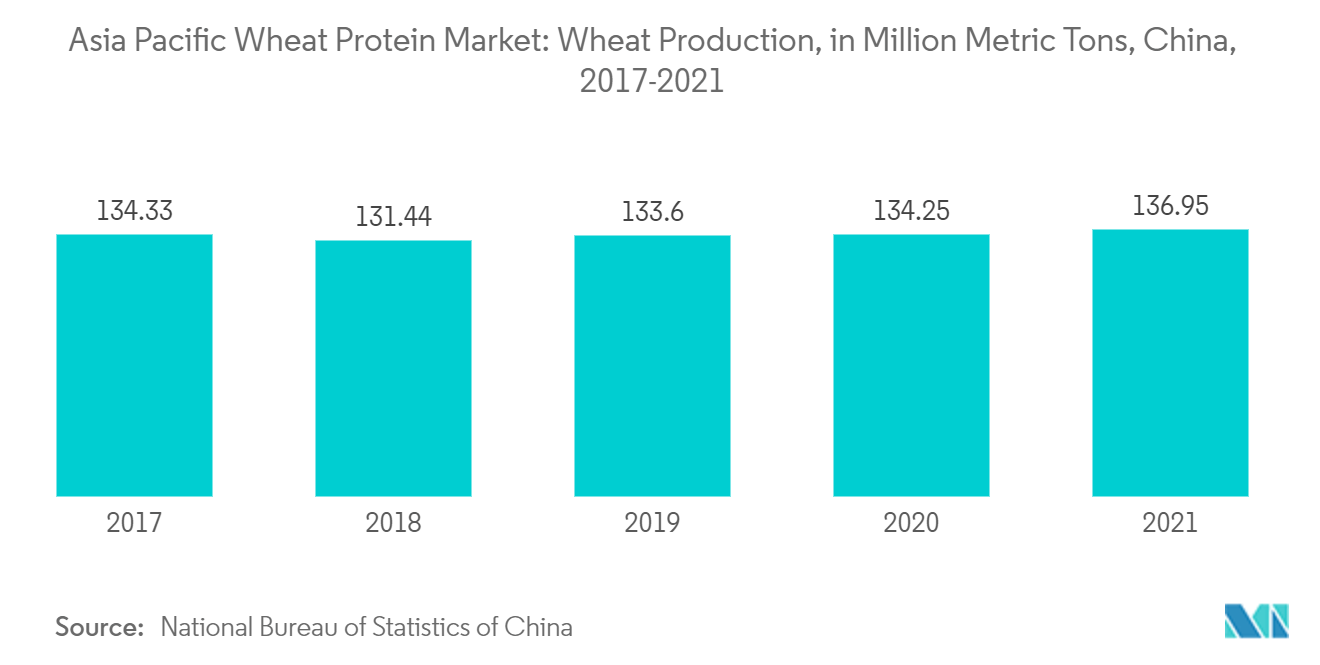
China and Japan are Expected to Have the Fastest Growing Market
- Countries such as China and Japan are expected to have the fastest-growing market in the Asia Pacific region, owing to the inclination of these consumers toward protein alternatives, such as plant protein, due to the reduction in animal protein intake, weight management, and general health maintenance. This has led to a rise in the daily intake of wheat protein, as it is one of the prominent plant-based proteins gaining traction in the Chinese market.
- In these countries, wheat protein is majorly used in bakery and meat substitute products. The great demand is due to the wide range of functionalities of wheat gluten, such as viscoelasticity, texturing, foaming, emulsification, and binding, leading to its wide-scale usage in bakery products and its role as an excellent meat alternative for consumers preferring vegetarian food products are expected to drive its market in the countries. The growth of such end-user industries can also play a significant role in the expansion of the wheat protein market across the region.
- According to the All Nippon Kashi Association, the production volume of cookies in Japan was valued at 249.9 thousand metric tons in the year 2022. According to the Japan Ministry of Tourism, there has been a steady increase in the number of the vegetarian population coming into the country. Most of the inbound vegetarian tourist consumers consume plant proteins regularly, which gives opportunities to the companies to process better quality plant-based proteins. Additionally, there has been a rise in awareness among the population residing in these nations regarding plant-based foods.
- For instance, according to a survey conducted in Japan by NH Foods Ltd., a food processing company, in 2022, 25.2% of respondents said that they knew about plant-based meat alternatives, and 33% responded that they had heard about them. As wheat protein is used in plant-based meat products, these factors can also play a crucial role in driving the market studied across the region.
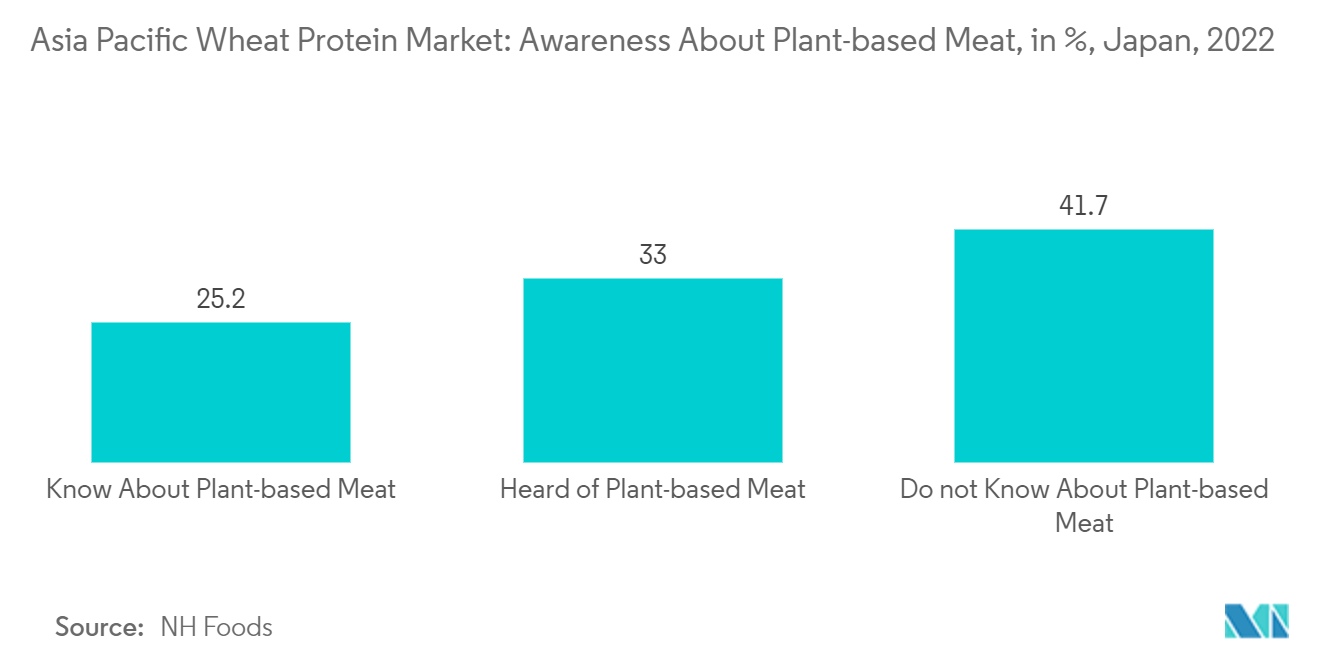
Competitive Landscape
The Asia-Pacific wheat protein market is competitive and fragmented owing to the presence of many regional and domestic players. Emphasis is given to the merger, expansion, acquisition, and partnership of the companies, along with new product development, as strategic approaches adopted by the leading companies to boost their brand presence among consumers. The companies operating in the market studied have been investing in the expansion of the production of their wheat protein products across the region.
Additionally, the companies have been focussing on research and development activities to innovate wheat protein and other such plant protein products, which could further drive the market studied. Key players dominating the market include MGP Ingredients Inc., Cargill Incorporated, Roquette Frères, The Archer-Daniels-Midland Company, and Shandong Qufeng Food Technology Co. Ltd., among others.
Asia Pacific Wheat Protein Industry Leaders
Cargill, Incorporated
The Archer-Daniels-Midland Company
Roquette Frères
Shandong Qufeng Food Technology Co. Ltd
MGP Ingredients Inc.
- *Disclaimer: Major Players sorted in no particular order
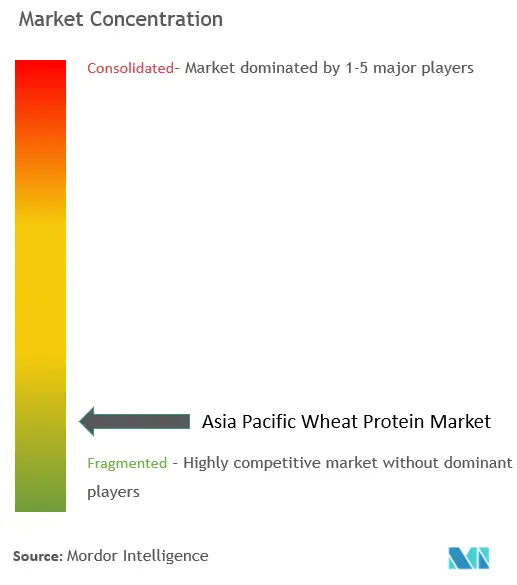
Recent Industry Developments
- November 2022: MGP Ingredients proudly announced that its Arise wheat protein isolates have received certification from Monash University in Melbourne, Australia, as low FODMAP ingredients. Arise wheat protein isolates now proudly display the Monash University low FODMAP certified icon, providing food formulators with the assurance that these ingredients will not induce abdominal discomfort or gas during digestion.
- September 2022: Cargill unveiled a strategic partnership with the Singapore Economic Development Board (EDB) to inaugurate its inaugural digital business studio in Asia. This studio was conceived to offer support and investments to local innovators, enabling them to create cutting-edge solutions for Cargill's market offerings and to expedite innovation within the food and agriculture sector across the Asia-Pacific region.
- April 2021: ADM inaugurated a new plant-based innovation lab within ADM's Biopolis research hub located in Singapore. The establishment of this innovation lab was aimed at fostering the development of nutritious solutions tailored specifically for the Asia-Pacific region.
Asia Pacific Wheat Protein Market Report Scope
Wheat protein can be defined as a natural plant-based protein derived from wheat.
The Asia-Pacific wheat protein market is segmented by type, application, and geography. Based on type, the market is segmented into wheat concentrate, wheat protein isolate, and textured wheat protein, and based on application, the market is segmented into dairy, bakery, sports food, confectionery, pet food, nutritional supplements, and other applications. Also, the study provides an analysis of the wheat protein market in the emerging and established markets across the Asia-Pacific, including China, Japan, Australia, India, and the Rest of Asia-Pacific.
The market sizing has been done in value terms in USD and for volume terms in volume in tons for all the abovementioned segments.
| Wheat Concentrate |
| Wheat Protein Isolate |
| Texturized Wheat Protein |
| Dairy |
| Bakery |
| Sports Food |
| Confectionery |
| Pet Food |
| Nutritional Supplements |
| Other Applications |
| China |
| Japan |
| Australia |
| India |
| Rest of Asia Pacific |
| Type | Wheat Concentrate |
| Wheat Protein Isolate | |
| Texturized Wheat Protein | |
| Application | Dairy |
| Bakery | |
| Sports Food | |
| Confectionery | |
| Pet Food | |
| Nutritional Supplements | |
| Other Applications | |
| Geography | China |
| Japan | |
| Australia | |
| India | |
| Rest of Asia Pacific |
Key Questions Answered in the Report
What is the current Asia Pacific Wheat Protein Market size?
The Asia Pacific Wheat Protein Market is projected to register a CAGR of 5.09% during the forecast period (2025-2030)
Who are the key players in Asia Pacific Wheat Protein Market?
Cargill, Incorporated, The Archer-Daniels-Midland Company, Roquette Frères, Shandong Qufeng Food Technology Co. Ltd and MGP Ingredients Inc. are the major companies operating in the Asia Pacific Wheat Protein Market.
What years does this Asia Pacific Wheat Protein Market cover?
The report covers the Asia Pacific Wheat Protein Market historical market size for years: 2019, 2020, 2021, 2022, 2023 and 2024. The report also forecasts the Asia Pacific Wheat Protein Market size for years: 2025, 2026, 2027, 2028, 2029 and 2030.
Page last updated on:
Asia Pacific Wheat Protein Market Report
Statistics for the 2025 Asia Pacific Wheat Protein market share, size and revenue growth rate, created by Mordor Intelligence™ Industry Reports. Asia Pacific Wheat Protein analysis includes a market forecast outlook for 2025 to 2030 and historical overview. Get a sample of this industry analysis as a free report PDF download.
